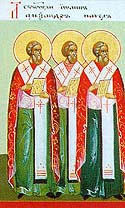
The First Council of Nicaea was a council of Christian bishops convened in the Bithynian city of Nicaea by the Roman Emperor Constantine I. The Council of Nicaea met from May until the end of July 325.

Theodoret of Cyrus or Cyrrhus was an influential theologian of the School of Antioch, biblical commentator, and Christian bishop of Cyrrhus (423–457).

Nicaea, also known as Nikaia, was an ancient Greek city in the north-western Anatolian region of Bithynia that is primarily known as the site of the First and Second Councils of Nicaea, the Nicene Creed, and as the capital city of the Empire of Nicaea following the Fourth Crusade in 1204, until the recapture of Constantinople by the Byzantines in 1261. Nicaea was also the capital of the Ottomans from 1331 to 1335.

Alexander of Constantinople was bishop of Byzantium from 314 and the first bishop of Constantinople from 330. Scholars consider most of the available information on Alexander to be legendary.

Paul I of Constantinople or Saint Paul the Confessor, was the sixth bishop of Constantinople, elected first in 337 AD. Paul became involved in the Arian controversy which drew in the Emperor of the West, Constans, and his counterpart in the East, his brother Constantius II. Paul was installed and deposed three times from the See of Constantinople between 337 and 350. He was murdered by strangulation during his third and final exile in Cappadocia. His feast day is on 6 November.
Macedonius 1 of Constantinople was a Greek bishop of Constantinople from 342 up to 346, and from 351 until 360. He inspired the establishment of the Pneumatomachi, a sect later declared heretical.
Eudoxius of Antioch was the eighth bishop of Constantinople from 27 January 360 to 370, previously bishop of Germanicia and of Antioch. Eudoxius was one of the most influential Arians.
Euphemius of Constantinople was Patriarch of Constantinople (489–495). Theophanes the Confessor calls him Euthymius. Prior to his appointment, Euphemius was a presbyter of Constantinople, administrator of a hospital for the poor at Neapolis, unsuspected of any Eutychian leanings, and is described as learned and very virtuous.
Macedonius II of Constantinople was Patriarch of Constantinople (495–511).
John of Cappadocia, surnamed Cappadox or the Cappadocian, was Patriarch of Constantinople in 518–520, during the reign of Byzantine emperor Anastasius I Dicorus after an enforced condemnation of the Council of Chalcedon. His short patriarchate is memorable for the celebrated Acclamations of Constantinople, and the reunion of East and West after a schism of 34 years. At the death of Timothy I of Constantinople, John of Cappadocia, whom he had designated his successor, was presbyter and chancellor of the Church of Constantinople.

Arius was a Cyrenaic presbyter and ascetic. He has been regarded as the founder of Arianism, which holds that Jesus Christ was not coeternal with God the Father, but was rather created before time. Arian theology and its doctrine regarding the nature of the Godhead showed a belief in subordinationism, a view notably disputed by 4th century figures such as Athanasius of Alexandria.
The Council of Seleucia was an early Christian church synod at Seleucia Isauria.

Paphnutius of Thebes, also known as Paphnutius the Confessor, was a dubiously historical early Christian figure, said to be a disciple of Anthony the Great and a bishop of a city in the Upper Thebaid in the early fourth century. He is accounted by some as a prominent member of the First Council of Nicaea which took place in 325. Neither the name of his see nor the precise date of his death are known.
The First Synod of Tyre or the Council of Tyre was a gathering of bishops called together at Tyre by Emperor Constantine I for the primary purpose of evaluating charges brought against Athanasius, the Patriarch of Alexandria, who was deposed by the council.
The Arian controversy was a series of Christian disputes about the nature of Christ that began with a dispute between Arius and Athanasius of Alexandria, two Christian theologians from Alexandria, Egypt. The most important of these controversies concerned the relationship between the substance of God the Father and the substance of His Son.
The Pneumatomachi, also known as Macedonians or Semi-Arians in Constantinople and the Tropici in Alexandria, were an anti-Nicene Creed sect which flourished in the regions adjacent to the Hellespont during the latter half of the fourth, and the beginning of the fifth centuries. They denied the godhood of the Holy Ghost, hence the Greek name Pneumatomachi or 'Combators against the Spirit'.
In 359, the Roman Emperor Constantius II requested a church council, at Constantinople, of both the eastern and western bishops, to resolve the split at the Council of Seleucia. According to Socrates Scholasticus, only about 50 of the Eastern bishops, and an unspecified number of the western ones, actually attended.

Isaac or Mar Isaac was the Persian bishop of Seleucia-Ctesiphon, grand metropolitan and primate of the Church of the East from 399 to 410. He is included in the traditional list of patriarchs of the Church of the East. He has also been canonized as a saint by various Apostolic churches.
Ursacius was the bishop of Singidunum, during the middle of the 4th century. He played an important role during the evolving controversies surrounding the legacies of the Council of Nicaea and the theologian Arius, acting frequently in concert with his fellow bishops of the Diocese of Pannonia, Germinius of Sirmium and Valens of Mursa. Found at various times during their episcopal careers staking positions on both sides of the developing theological debate and internal Church politicking, Ursacius and his fellows were seen to vacillate according to the political winds.
Valens of Mursa was bishop of Mursa and a supporter of Homoian theology, which is often labelled as a form of Arianism, although semi-Arianism is probably more accurate.